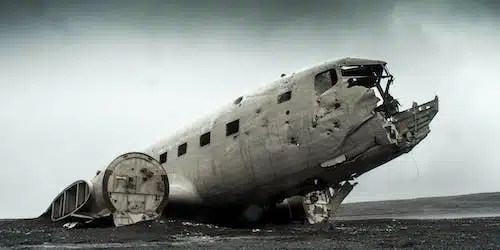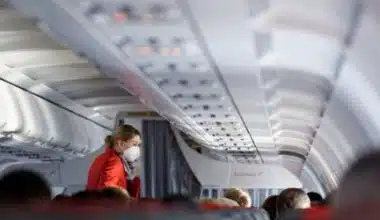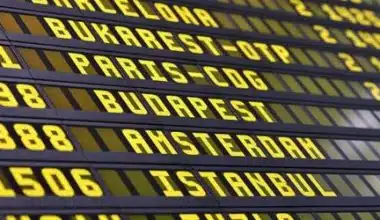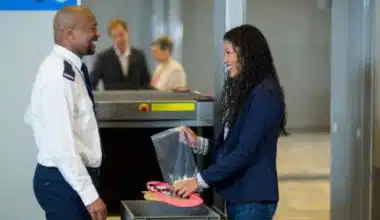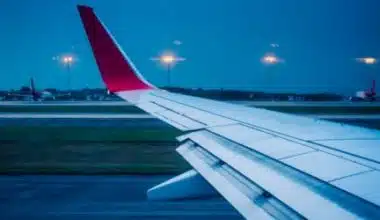Air travel safety is a top concern for anyone taking to the skies. Discover the frequency of airplane crashes and the factors that contribute to the impressive safety record of commercial aviation. Plane crashes occur annually, with an average of 6,000–7,000 worldwide. In this article, we will be listing the factors affecting plane crashes, the types, and the impact, among others. Also, these factors can lead to severe consequences, making aviation safety a crucial concern.
How Often Do Planes Crash?
The number of plane crashes varies from year to year, but on average, there are between 6,000 and 7,000 crashes per year worldwide, including both commercial planes and privately owned ones. Plane crashes are relatively rare occurrences, and flying remains one of the safest modes of transportation. However, when aviation accidents do happen, the consequences can be devastating. The frequency of plane crashes can vary depending on various factors, including the type of aircraft, the region, and the specific time.
Factors Affecting Plane Crash Frequency
Several factors can affect the frequency of plane crashes. These factors can vary from mechanical issues to human error.
They include:
#1. Mechanical Issues
Mechanical failures or malfunctions in the aircraft can contribute to plane crashes. These issues can include engine failures, structural problems, or faulty equipment.
#2. Human Error
Human error is one of the leading causes of plane crashes. This can include errors made by pilots, air traffic controllers, or maintenance personnel. Examples of human error include pilot error, miscommunication, or failure to follow proper procedures.
#3. Weather Conditions
Adverse weather conditions can significantly impact flight safety and increase the risk of plane crashes. Severe weather events such as thunderstorms, heavy fog, or strong winds can make flying more challenging and increase the likelihood of accidents.
#4. Pilot Fatigue
Fatigue can impair a pilot’s judgment, reaction time, and decision-making abilities, increasing the risk of accidents. Long working hours, irregular schedules, and insufficient rest periods can contribute to pilot fatigue.
#5. Air Traffic Control Errors
Mistakes made by air traffic controllers can lead to mid-air collisions or other accidents. Miscommunication, errors in providing instructions, or failure to detect potential conflicts can all contribute to plane crashes.
#6. Terrorism and Sabotage
Acts of terrorism or sabotage can pose a significant threat to aviation safety. Deliberate acts of violence, such as hijackings or bombings, can result in catastrophic accidents.
#7. Pilot Training and Experience
Inadequate pilot training or lack of experience can increase the risk of accidents. Pilots with insufficient training may struggle to handle emergencies or make critical decisions under pressure.
#8. Maintenance Issues
Poor maintenance practices or inadequate inspections can lead to mechanical failures and increase the risk of accidents. Neglecting regular maintenance or failing to address known issues can compromise the safety of the aircraft.
#9. Airline Safety Culture
The safety culture within an airline can greatly influence the likelihood of accidents. Airlines with a strong commitment to safety, effective training programs, and a proactive approach to risk management are more likely to have lower crash frequencies.
#10. Type of Aircraft
The crash rates can vary depending on the model and type of aircraft. Some aircraft models have better safety records than others.
Types of Plane Crashes
There are various types of plane crashes, each with its own characteristics and causes. Here are some common types:
#1. Controlled Flight Into Terrain (CFIT)
CFIT occurs when an aircraft unintentionally collides with terrain, water, or an obstacle while still under the pilot’s control. This type of crash often happens due to poor visibility, pilot error, or navigational mistakes.
#2. Mid-Air Collisions
Mid-air collisions involve two or more aircraft colliding while in flight. These accidents can occur due to errors in air traffic control, miscommunication between pilots, or failure to maintain proper separation between aircraft.
#3. Runway Incursions
Runway incursions happen when an aircraft, vehicle, or person enters an active runway without authorization. This can lead to collisions with other aircraft on the runway or cause accidents during takeoff or landing.
#4. Loss of Control In-Flight (LOC-I)
LOC-I refers to situations where the pilot loses control of the aircraft during flight. This can occur due to factors such as mechanical failures, extreme weather conditions, or pilot error. LOC-I accidents are often challenging to recover from and can result in crashes.
#5. Engine Failures
Engine failures can lead to plane crashes if the aircraft is unable to maintain sufficient power for flight. This can occur due to mechanical malfunctions, fuel system issues, or foreign object ingestion.
#6. Structural Failures
Structural failures involve the failure of critical components or structures of the aircraft, such as the wings, fuselage, or tail. Metal fatigue, flaws in the manufacturing process, or improper maintenance are some of the causes of these failures.
#7. Fire and Explosions
Fires and explosions on board an aircraft can lead to catastrophic accidents. These incidents can be caused by factors such as fuel leaks, electrical malfunctions, or hazardous materials on board.
Adverse weather conditions, such as severe storms, icing, or strong winds, can contribute to plane crashes. These conditions can affect the aircraft’s performance, visibility, and control, increasing the risk of accidents.
#9. Sabotage and Terrorism
Acts of sabotage or terrorism, such as bombings or hijackings, can result in plane crashes. These intentional acts of violence pose a significant threat to aviation safety.
#10. Descent and Landing
This type of accident is the most common in general aviation, accounting for 37% of all accidents. It occurs during the descent and landing stages of flight
Impact of Plane Crash Frequency
The impact of plane crash frequency can be significant and wide-ranging.
Here are some key points regarding the impact of plane crashes:
#1. Loss of Life and Injuries
Plane crashes can result in the loss of many lives and cause severe injuries to survivors. The number of fatalities and injuries can vary depending on the severity of the crash, the number of occupants, and other factors.
#2. Psychological Impact
Plane crashes can have a profound psychological impact on survivors, their families, and the broader community. Witnessing or experiencing a plane crash can lead to post-traumatic stress disorder (PTSD), anxiety, depression, and other mental health issues.
#3. Economic Consequences
Plane crashes can have significant economic consequences. The loss of aircraft, infrastructure damage, legal settlements, and insurance claims can result in substantial financial losses for airlines, manufacturers, and other stakeholders.
#4. Safety Improvements
Plane crashes often lead to investigations and safety improvements in the aviation industry. Crash investigations help identify the causes and contributing factors of accidents, leading to the implementation of new safety measures, regulations, and technological advancements to prevent similar incidents in the future.
#5. Public Perception and Confidence
Plane crashes can impact public perception and confidence in air travel. High-profile crashes may lead to increased fear and anxiety among potential passengers, affecting the demand for air travel.
#6. Regulatory Changes
Plane crashes can prompt regulatory changes and stricter enforcement of safety standards. Aviation authorities may revise regulations, conduct more rigorous inspections, and enhance training requirements for pilots, air traffic controllers, and maintenance personnel.
#7. Lessons Learned
Each plane crash provides an opportunity to learn valuable lessons and improve safety practices. Crash investigations and reports help identify systemic issues, human errors, or technical failures, leading to recommendations for improvement in various areas of aviation safety.
#8. Legal and Insurance Considerations
Plane crashes often lead to legal proceedings and insurance claims. Families of victims may file lawsuits against airlines, aircraft manufacturers, or other parties they believe are responsible for the crash. Insurance companies may also face significant financial liabilities due to loss of life, property damage, and legal settlements.
#9. Impact on Airline Reputation
High-profile plane crashes can have a lasting impact on the reputation of the involved airlines. Public perception of an airline’s safety record and reliability can be affected, leading to decreased passenger trust and potential loss of business. Airlines may need to invest in reputation management and rebuilding trust through improved safety measures and transparent communication.
#10. Impact on Local Communities
Plane crashes can significantly impact the local communities where they occur. In addition to the loss of life, crashes can cause damage to property, infrastructure, and the environment. The recovery and cleanup process can take time and resources, and the community may require support in terms of counseling services, financial assistance, and infrastructure repair.
#11. Impact on Travel and Tourism
Plane crashes can hurt travel and tourism, especially if they occur in popular tourist destinations. Travelers may avoid visiting the affected area due to safety concerns, resulting in a decline in tourism revenue. This can have long-term economic repercussions for the local economy and businesses dependent on tourism.
How Airlines Prevents Plane Crashes
Airlines employ various measures and strategies to prevent plane crashes and enhance aviation safety. Here are ways in which airlines work towards preventing plane crashes:
#1. Pilot Training and Qualifications
Airlines prioritize comprehensive and rigorous pilot training programs. Pilots undergo extensive training to develop their skills, knowledge, and decision-making abilities. This includes simulator training, emergency procedures, and recurrent training to stay updated with the latest aviation practices.
#2. Safety Management Systems (SMS)
Airlines implement safety management systems, which are proactive and systematic approaches to managing safety risks. SMS involves identifying hazards, assessing risks, implementing safety measures, and continuously monitoring and improving safety performance.
#3. Maintenance and Inspections
Airlines adhere to strict maintenance protocols and conduct regular inspections of their aircraft. Maintenance personnel follow manufacturer guidelines and perform routine checks to ensure the airworthiness of the planes. Any identified issues are promptly addressed and resolved.
#4. Compliance with Regulations
Airlines comply with aviation regulations set by national and international authorities. These regulations cover various aspects of aviation safety, including aircraft design, maintenance standards, pilot qualifications, and operational procedures. Compliance ensures that airlines meet the required safety standards.
#5. Enhanced Aircraft Design and Technology
Aircraft manufacturers continuously improve the design and technology of airplanes to enhance safety. This includes advancements in aerodynamics, structural integrity, avionics systems, and safety features. Manufacturers work closely with airlines and regulatory bodies to address any identified safety concerns.
#6. Risk Assessment and Mitigation
Airlines conduct thorough risk assessments to identify potential hazards and mitigate risks. This involves analyzing factors such as weather conditions, route planning, airspace congestion, and potential threats. By identifying and addressing risks, airlines aim to minimize the likelihood of accidents.
Airlines collaborate with regulatory authorities, such as the Federal Aviation Administration (FAA), to ensure compliance with safety regulations. They actively participate in safety programs, share safety-related information, and work together to address emerging safety issues.
#8. Incident Reporting and Investigation
Airlines encourage a culture of incident reporting and investigation. This allows them to identify and analyze safety-related incidents, near misses, and potential hazards. By learning from these incidents, airlines can implement corrective actions and preventive measures to enhance safety.
#9. Continuous Training and Education
Airlines provide ongoing training and education to their employees, including pilots, cabin crew, and ground staff. This includes safety briefings, emergency procedure training, and regular updates on safety-related topics. Continuous training ensures that employees are equipped with the necessary knowledge and skills to handle various situations.
#10. Improved Air Traffic Control
Airlines work closely with air traffic control authorities to ensure the safe and efficient management of air traffic. Advanced radar systems, communication protocols, and real-time monitoring help prevent mid-air collisions and maintain safe separation between aircraft.
How Many Airline Plane Crashes A Year?
Globally, there are an average of 6,392 plane crashes per year. However, this figure includes all types of aircraft, including general aviation and private planes, and not just commercial airliners.
How Many Plane Crashes Per Day?
There are around 17.1 plane crashes per day. The data encompasses all types of aircraft, including commercial, private, and general aviation.
When Was The Last Plane Crash In The World?
The last plane crash in the world occurred on January 15, 2023. A Boeing 737 passenger plane crashed shortly after take-off from Jose Marti International Airport in Havana, Cuba, resulting in the tragic loss of 112 lives.
What Is The #1 Cause Of Plane Crashes?
The number-one cause of plane crashes is pilot error. Pilot error accounts for a significant proportion of aviation accidents, with estimates ranging from around 50% to 55% of crashes being attributed to pilot error Piloting an aircraft requires extensive training, knowledge of aircraft mechanics, and the ability to effectively and safely maneuver the aircraft. Mistakes or lapses in judgment by pilots, such as programming flight-management computers incorrectly or miscalculating fuel requirements, can contribute to accidents.
Which Airlines Are The Safest?
Several airlines as among the safest in the world, including Qantas, Air New Zealand, Etihad Airways, Qatar Airways, Singapore Airlines, TAP Air Portugal, Emirates, Alaska Airlines, EVA Air, Virgin Australia/Atlantic, Cathay Pacific Airways, Hawaiian Airlines, SAS, United Airlines, Lufthansa/Swiss Group, Finnair, British Airways, KLM, American Airlines, and Delta Air Lines. These rankings are based on factors such as incident records, technological innovations, fleet age, and pilot training.
Which Airline Has Never Had A Crash?
Some airlines, like Qantas, Southwest Airlines, Ryanair, and Etihad Airways, have never experienced a fatal crash, demonstrating their commitment to safety and safety measures. Reputable airlines prioritize safety, investing in training, maintenance, and safety measures to ensure passenger well-being.
What Is the Non-Safest Airline?
Airline safety rankings and assessments can vary depending on the criteria used and the specific year of the assessment. All reputable airlines prioritize safety and invest in training, maintenance, and safety measures to ensure the well-being of their passengers. It is not possible to determine a specific non-safest airline.
Conclusion
Plane crash frequency has significant impacts on various aspects of aviation, including loss of life, psychological effects, economic consequences, safety improvements, public perception, and regulatory changes. These incidents can lead to increased fear and anxiety, affecting demand for air travel and prompting stricter safety standards. Airlines use various strategies to prevent plane crashes, including pilot training, safety management systems, regular maintenance, and others. These measures aim to enhance aviation safety, minimize accidents, and ensure the safety of passengers and crews.
- CRUISE INSURANCE: What Is Covers
- HOW MUCH DOES AN AIR TRAFFIC CONTROLLER (ATC) MAKE?
- WHEN IS HURRICANE SEASON IN PUERTO RICO? All You Need To Know
- CRUISE SHIP DEATH: A Comprehensive Guide to Causes and Prevention
- WHY ARE AIRLINES CANCELING FLIGHTS?
